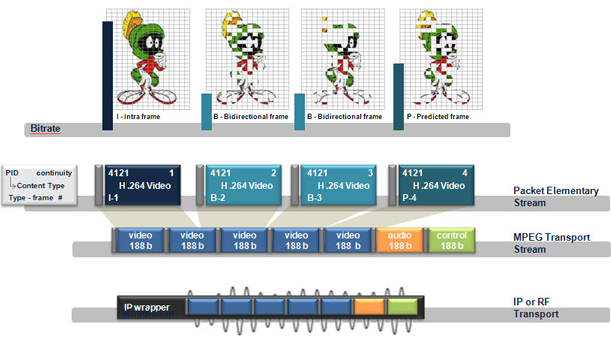MPEG basics
MPEG is a compression technique that allows for optimized usage of bandwidth for image transmission.
The MPEG compression works in two ways:
• Intra-frame compression
uses an algorithm to calculate color differences between clusters of pixels. So the information transmitted is only a differential of data between clusters instead of complete pixel-by-pixel data.
• Inter-frame compression
In each frame of video, there are portions of the previous frame that remain unchanged. The inter-frame compression eliminates the "redundant" information of unchanged pixels and only sends differential information of the portions that moved or had chrominance or luminance changes. Evidently, the compression is more efficient on low-motion programs such as a news report than it is on a fast-motion program such as a football game.
The MPEG elementary stream contains 3 types of packets:
• I frame
This frame only has intra-frame compression and it is used as reference to build subsequent frames using differences
• B frame
It uses information available on the previous and the next frame to be reconstructed. It is the frame type that takes the least bandwidth.
• P frame
This frame is predicted form the previous one only.

After the video is compressed, the PES-Packet Elementary Stream is converted into a standardized format known as MPEG transport stream. This stream typically consists of 7 packets with 188 bits. These packets may transport video, audio, metadata (control signals) or stuffing bits.
Video in the Broadcasting Environment
Broadcasting companies handle video from multiple acquisition sources and through distribution methods.
In addition to the traditional television delivery, there is an increasing demand for video over the web and mobile devices. These new technologies require new transmission methods and protocols.
Key workflow challenges for broadcasters:
• The distribution of content depends on regional affiliates that are often owned by third parties
• A large percentage of the viewer base receives the content through carriers
Broadcasters have limited visibility into the video processing workflows in these third party segments of their distribution chain, making it hard to control that the correct content is delivered with the original quality to all viewers.
Video in the Carrier Environment
Delivery of video content and services is complex.
• Quality expectation is high, but bandwidth usage must be minimized.
• Content passes through multiple processes, network segments and transport methods where errors and faults can be introduced
• Verification of video and transport quality at the interface points and at the viewer’s location.